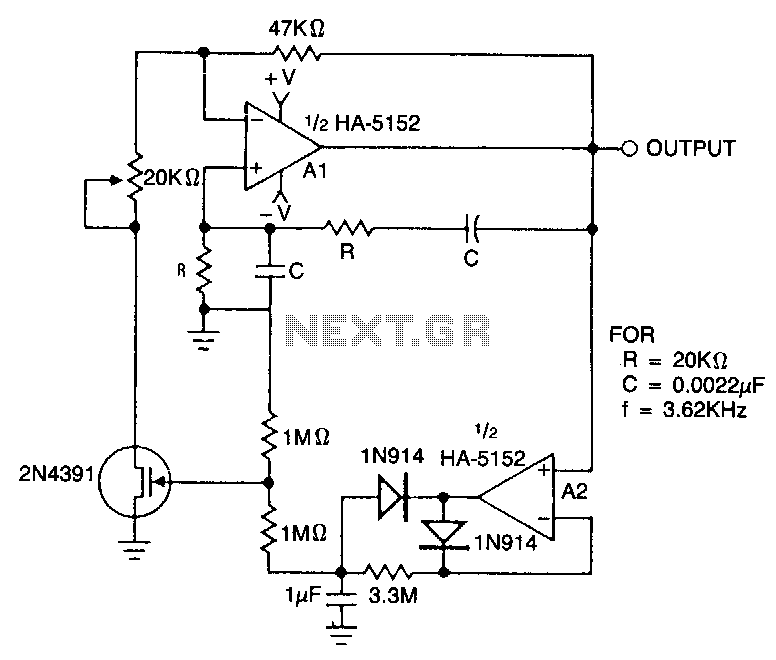
Low-voltage-wien-bridge-oscillator

This circuit employs an HA-5152 dual operational amplifier and a field-effect transistor (FET) to create a low-voltage, low-power Wien bridge sine-wave oscillator. The frequency of oscillation is controlled by resistors and capacitors, while the FET functions as a voltage-controlled resistor to maintain the gain of amplifier A1 at exactly 3 dB to ensure sustained oscillation. A 20 kΩ potentiometer allows for the adjustment of signal amplitude. The HA-5152 can operate from ±1.5 V power supplies. Additionally, this circuit generates a low-distortion sine-wave output while consuming only 400 µA of supply current.
The circuit design utilizes the HA-5152 dual op-amp, which is known for its low noise and high performance in precision applications. The Wien bridge oscillator configuration is a classic method for generating sine waves, characterized by its ability to produce low-distortion outputs. The resistors and capacitors in the circuit are selected based on the desired frequency of oscillation, with the relationship defined by the formula f = 1 / (2πRC), where R is the resistance and C is the capacitance in the feedback loop.
The FET serves a critical role in stabilizing the gain of the oscillator. By functioning as a variable resistor, it can adjust the feedback in response to the output amplitude, ensuring that the gain remains at the necessary 3 dB. This feedback mechanism is essential for sustaining oscillation without introducing distortion or instability.
The inclusion of a 20 kΩ potentiometer provides the user with the flexibility to modulate the output amplitude, allowing for a range of applications from audio signal generation to waveform testing. The low supply current of 400 µA is particularly advantageous for battery-operated devices, making this circuit suitable for low-power applications.
Overall, this Wien bridge sine-wave oscillator circuit is an efficient solution for generating clean sine waveforms in a compact form factor, with the added benefits of low power consumption and adjustable output amplitude.This circuit utilizes an HA-5152 dual op amp and FET to produce a low-voltage, low-power, Weinbridge sine-wave oscillator. Resistors R and capacitors C control the frequency of oscillation; the FET, used as a voltage-controlled resistor, maintains the gain of A1 exactly 3 dB to sustain oscillation.
The 20Kfl pot can be used to vary the signal amplitude. The HA-5152 has the capability to operate from ± 1.5-V supplies. This circuit will produce a low-distortion sine-wave output while drawing only 400 uA of supply current. 🔗 External reference
The circuit design utilizes the HA-5152 dual op-amp, which is known for its low noise and high performance in precision applications. The Wien bridge oscillator configuration is a classic method for generating sine waves, characterized by its ability to produce low-distortion outputs. The resistors and capacitors in the circuit are selected based on the desired frequency of oscillation, with the relationship defined by the formula f = 1 / (2πRC), where R is the resistance and C is the capacitance in the feedback loop.
The FET serves a critical role in stabilizing the gain of the oscillator. By functioning as a variable resistor, it can adjust the feedback in response to the output amplitude, ensuring that the gain remains at the necessary 3 dB. This feedback mechanism is essential for sustaining oscillation without introducing distortion or instability.
The inclusion of a 20 kΩ potentiometer provides the user with the flexibility to modulate the output amplitude, allowing for a range of applications from audio signal generation to waveform testing. The low supply current of 400 µA is particularly advantageous for battery-operated devices, making this circuit suitable for low-power applications.
Overall, this Wien bridge sine-wave oscillator circuit is an efficient solution for generating clean sine waveforms in a compact form factor, with the added benefits of low power consumption and adjustable output amplitude.This circuit utilizes an HA-5152 dual op amp and FET to produce a low-voltage, low-power, Weinbridge sine-wave oscillator. Resistors R and capacitors C control the frequency of oscillation; the FET, used as a voltage-controlled resistor, maintains the gain of A1 exactly 3 dB to sustain oscillation.
The 20Kfl pot can be used to vary the signal amplitude. The HA-5152 has the capability to operate from ± 1.5-V supplies. This circuit will produce a low-distortion sine-wave output while drawing only 400 uA of supply current. 🔗 External reference